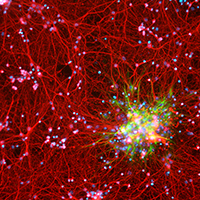Quantitative, structural and molecular changes in neuroglia of aging mammals: A review

Accepted: 27 May 2021
HTML: 11
All claims expressed in this article are solely those of the authors and do not necessarily represent those of their affiliated organizations, or those of the publisher, the editors and the reviewers. Any product that may be evaluated in this article or claim that may be made by its manufacturer is not guaranteed or endorsed by the publisher.
Authors
The neuroglia of the central and peripheral nervous systems undergo numerous changes during normal aging. Astrocytes become hypertrophic and accumulate intermediate filaments. Oligodendrocytes and Schwann cells undergo alterations that are often accompanied by degenerative changes to the myelin sheath. In microglia, proliferation in response to injury, motility of cell processes, ability to migrate to sites of neural injury, and phagocytic and autophagic capabilities are reduced. In sensory ganglia, the number and extent of gaps between perineuronal satellite cells – that leave the surfaces of sensory ganglion neurons directly exposed to basal lamina– increase significantly. The molecular profiles of neuroglia also change in old age, which, in view of the interactions between neurons and neuroglia, have negative consequences for important physiological processes in the nervous system. Since neuroglia actively participate in numerous nervous system processes, it is likely that not only neurons but also neuroglia will prove to be useful targets for interventions to prevent, reverse or slow the behavioral changes and cognitive decline that often accompany senescence.
How to Cite
PAGEPress has chosen to apply the Creative Commons Attribution NonCommercial 4.0 International License (CC BY-NC 4.0) to all manuscripts to be published.
Similar Articles
- Nuobei Zhang, Hao Shen, Shenan Huang, Fenfen Wang, Huifang Liu, Fen Xie, Lei Jiang, Xin Chen, LncRNA FGD5-AS1 functions as an oncogene to upregulate GTPBP4 expression by sponging miR-873-5p in hepatocellular carcinoma , European Journal of Histochemistry: Vol. 65 No. 4 (2021)
- Xiaoyan Chu, Jun Lou, Yun Yi, Linlin Zhong, Ouping Huang, Knockdown of ARHGAP30 inhibits ovarian cancer cell proliferation, migration, and invasiveness by suppressing the PI3K/AKT/mTOR signaling pathway , European Journal of Histochemistry: Vol. 67 No. 2 (2023)
- D. Cabibi, A.G. Giannone, C. Mascarella, C. Guarnotta, M. Castiglia, G. Pantuso, E. Fiorentino, Immunohistochemical/histochemical double staining method in the study of the columnar metaplasia of the oesophagus , European Journal of Histochemistry: Vol. 58 No. 1 (2014)
- D. Fanni, N. Iacovidou, A. Locci, C. Gerosa, S. Nemolato, P. Van Eyken, G. Monga, S. Mellou, G. Faa, V. Fanos, MUC1 marks collecting tubules, renal vesicles, comma- and S-shaped bodies in human developing kidney , European Journal of Histochemistry: Vol. 56 No. 4 (2012)
- Elva I. Cortés Gutiérrez, Catalina García-Vielma, Adriana Aguilar-Lemarroy, Veronica Vallejo-Ruíz, Patricia Piña-Sánchez, Pablo Zapata-Benavides, Jaime Gosalvez, Expression of the HPV18/E6 oncoprotein induces DNA damage , European Journal of Histochemistry: Vol. 61 No. 2 (2017)
- R. M. Ruggeri, E. Vitarelli, G. Barresi, F. Trimarchi, S. Benvenga, M. Trovato, The tyrosine kinase receptor c-met, its cognate ligand HGF and the tyrosine kinase receptor trasducers STAT3, PI3K and RHO in thyroid nodules associated with Hashimoto's thyroiditis: an immunohistochemical characterization , European Journal of Histochemistry: Vol. 54 No. 2 (2010)
- A. Porzionato, M. M. Sfriso, V. Macchi, A. Rambaldo, G. Lago, L. Lancerotto, V. Vindigni, R. De Caro, Decellularized omentum as novel biologic scaffold for reconstructive surgery and regenerative medicine , European Journal of Histochemistry: Vol. 57 No. 1 (2013)
- Andreea Cioca, Amalia R. Ceausu, Irina Marin, Marius Raica, Anca M. Cimpean, The multifaceted role of podoplanin expression in hepatocellular carcinoma , European Journal of Histochemistry: Vol. 61 No. 1 (2017)
- M. Costanzo, F. Carton, A. Marengo, G. Berlier, B. Stella, S. Arpicco, M. Malatesta, Fluorescence and electron microscopy to visualize the intracellular fate of nanoparticles for drug delivery , European Journal of Histochemistry: Vol. 60 No. 2 (2016)
- Liuchang Feng, Zaoqiang Lin, Zeyong Tang, Lin Zhu, Shu Xu, Xi Tan, Xinyuan Wang, Jianling Mai, Qinxiang Tan, Emodin improves renal fibrosis in chronic kidney disease by regulating mitochondrial homeostasis through the mediation of peroxisome proliferator-activated receptor-gamma coactivator-1 alpha (PGC-1α) , European Journal of Histochemistry: Vol. 68 No. 2 (2024)
<< < 9 10 11 12 13 14 15 16 17 18 > >>
You may also start an advanced similarity search for this article.

 https://doi.org/10.4081/ejh.2021.3249
https://doi.org/10.4081/ejh.2021.3249










